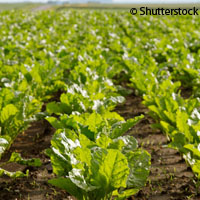Plants have immune systems too!
Whilst we might be well aware of the presence of the human immune system, it now appears that plants have their very own extensive defence strategies in place as well. In a study published in Science Express, researchers from Wageningen University in the Netherlands and the Lawrence Berkeley National Laboratory in the United States have identified for the first time how a network of soil microbes can work together to fend off plant-killing pathogens. The team made the discovery after looking closely at soil from a sugar beet field in the Netherlands that had become resistant to the root fungus-causing pathogen Rhizoctonia solani. Although disease-suppressive soils are quite common, until now only some of the microbes involved in this immune system for plants have been identified, and previous studies have turned up only a handful of microbes fighting against pathogens. In this study, the team found 17 soil microbes at work trying to suppress the killer pathogen, which can cause chaos among beets, plants and rice alike. To identify these microbes, the team used a credit-card sized chip capable of detecting the presence of 59,000 species of bacteria and archaea in samples of air, water and soil without the need of culturing. This chip was developed at the Lawrence Berkeley Lab to help identify not only the most typical and well-known organisms in an environmental sample, but also the rarer types that are less abundant. It works by comparing a DNA sequence unique to each bacterial species with over one million reference DNA targets on the chip. 'Individual organisms have been associated with disease-suppressive soil before, but we demonstrated that many organisms in combination are associated with this phenomenon,' comments Gary Andersen, one of the researchers from the Lawrence Berkeley National Laboratory. Typically, sugar beets planted in disease-suppressive soil follow a cycle that begins with a few pathogen-free years before they succumb to disease. The plants then become healthy once the pathogen-fighting microbes are activated and the soil becomes hostile to the pathogen. The soil samples used in the study were orchestrated to show six of these different stages of disease suppression from the sugar beet field. DNA samples from these samples were analysed and more than 33,000 bacterial and archaeal species were found in the samples. Although there was little variation found between the microbes present at the six different stages of the soil cycle, when each sample was analysed it turned out that within the abundance of bacteria each sample had a unique bacterial make-up. All of the samples in which disease was suppressed had a greater abundance of 17 unique types of bacteria. These included well-known 'fungal fighters' such as Pseudomonas, Burkholderia, Xanthomonas and Actinobacteria. Other types of bacteria that have no demonstrated ability to fight pathogens on their own were also found to be present in some samples; this suggests they act synergistically to suppress plant disease along with other bacteria. The implications of these findings are that for soil to be good at combating pathogens it is better to have a strong 'team' of different types of bacteria compared to having just one or two pathogen killers. 'We now see that the complex phenomenon of disease suppression in soils cannot simply be attributed to a single bacterial group, but is most likely controlled by a community of organisms,' explains Gary Andersen. These results will hopefully aid scientists understand unanswered questions about just how disease-suppressive soil attracts these protective microbes and in turn help farmers and growers work towards combating economically damaging plant disease.For more information, please visit:Lawrence Berkeley National Laboratory:http://www.lbl.gov/Wageningen University:http://www.wur.nl/uk/
Countries
Netherlands, United States



